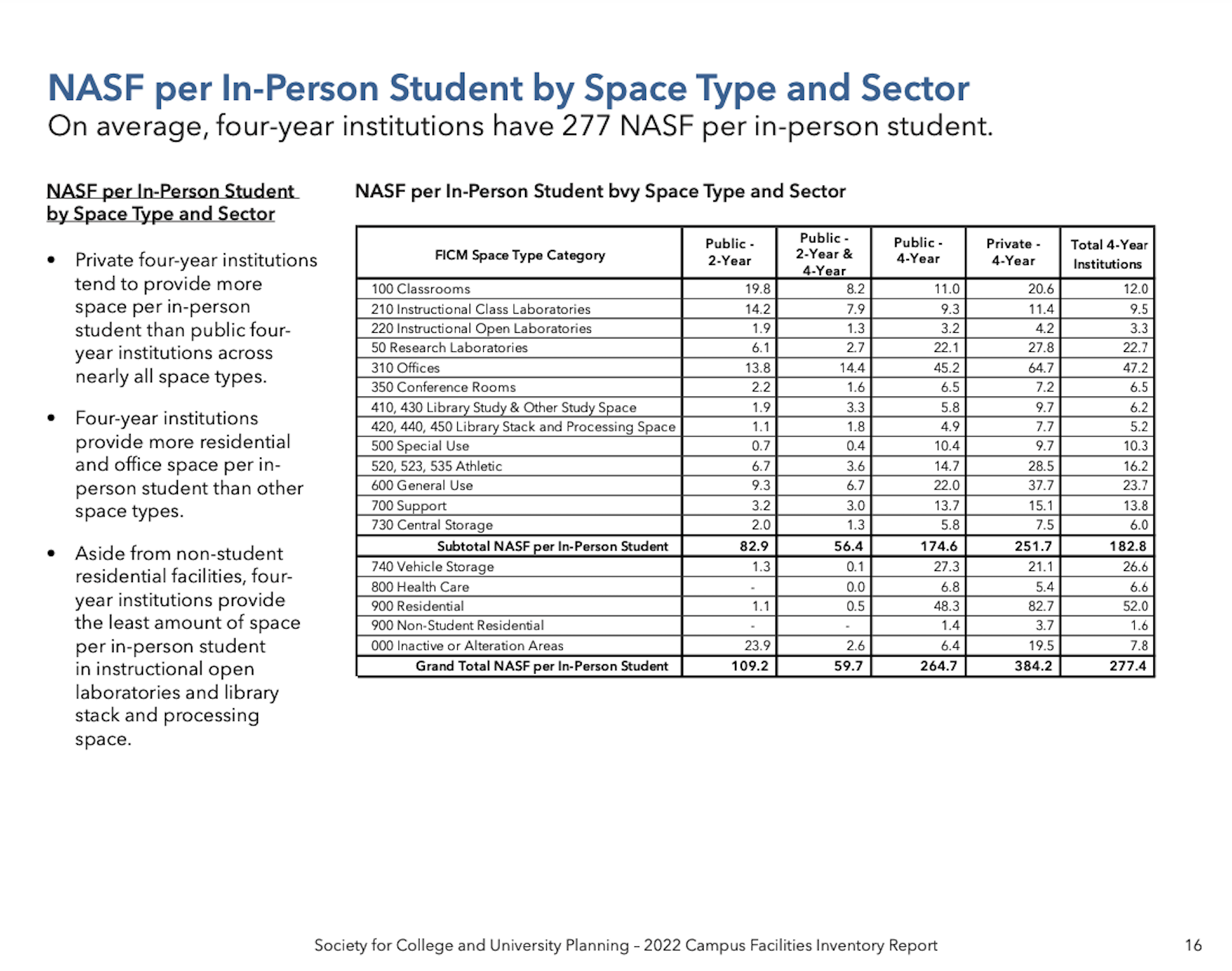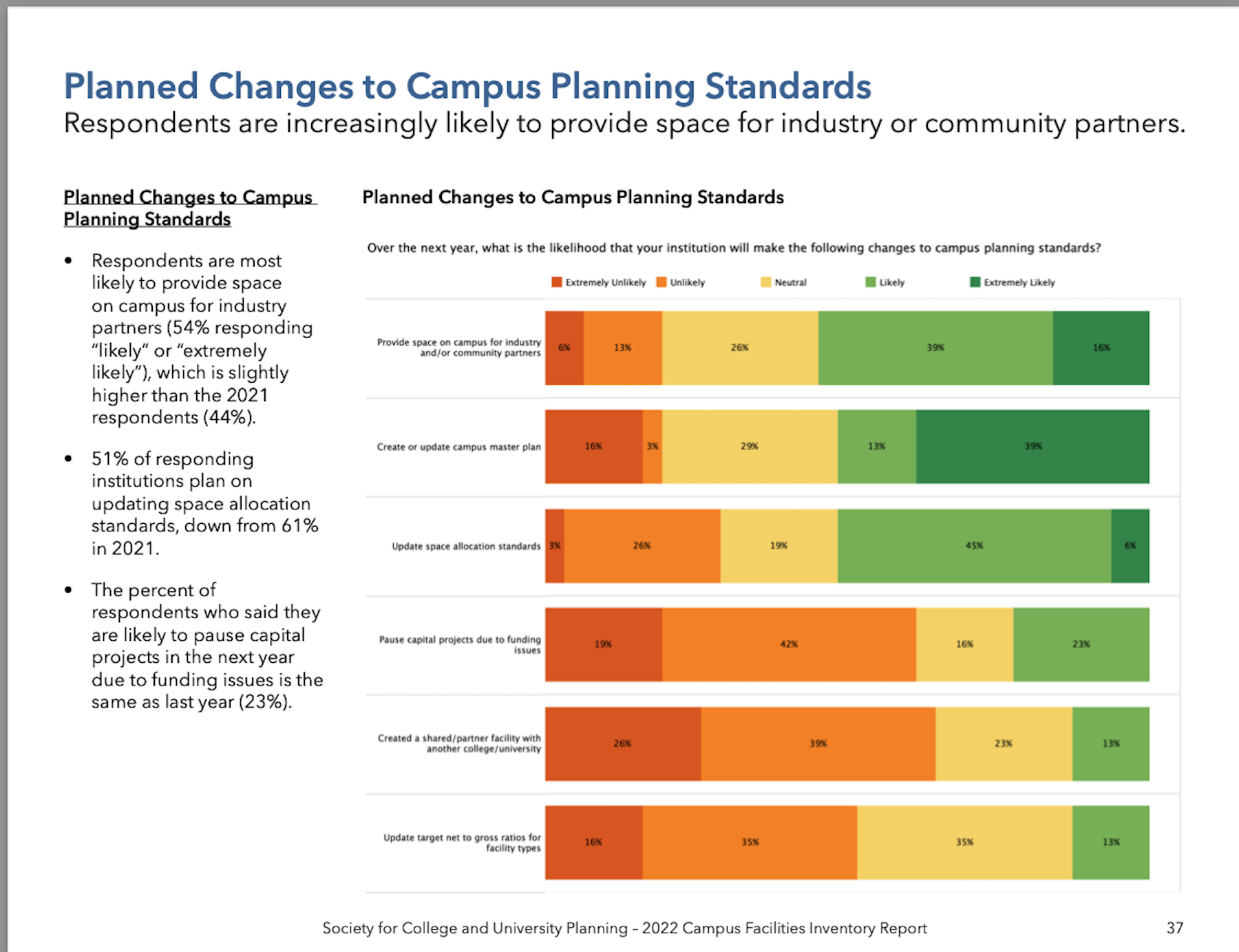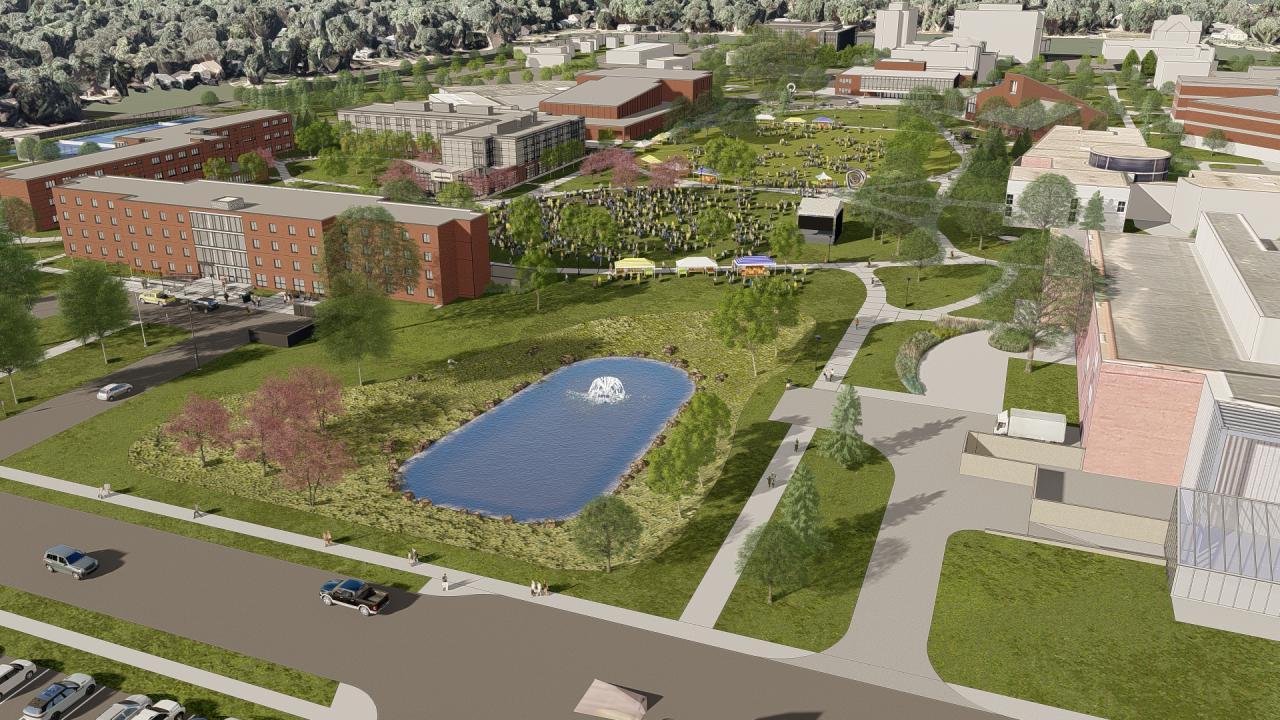Private four-year academic institutions provide more space per in-person student than other sectors. Town and rural schools provide more space per in-person student than urban and suburban schools. Institutions with fewer than 5,000 in-person students offer the most instructional space per in-person student. And small public four-year institutions provide much more research lab space than small private four-year schools.
These are some of the findings in the Society for College and University Planning’s 2022 Campus Facilities Inventory Report. CFI is a national database that helps universities compare their campus development to peer institutions. The quantitative section of the 2022 Report is based on responses from 104 institutions across the U.S. and one in Canada, and its results were released a few weeks ago.


SCUP, a nonprofit professional association that since 1966 has supported college planners, in 2021 partnered with brightspot strategy, a Buro Happold company, to relaunch the Campus Facilities Inventory, (CFI) which originally had been collected and published in 2003-2007. The latest CFI increases the room-use categories tracked to 19, from 15 in the original version. The categories are derived from the National Center for Education Statistics Postsecondary Education Facilities Inventory and Classification Manual.
A sample of the CFI findings shows that small private four-year institutions average 58.7 net aggregate square feet of instructional space per in-person student compared to 35.2 sf that their public counterparts offer.
DEVELOPMENT PLANS GAUGED

The 2022 Report includes questions about qualitative changes to space on campus—both changes that have been made recently or are likely to be made in the next three years. Thirty-one institutions participated in this part of the survey, the majority of which are four-year public schools. The survey found that respondents are more likely to update or adapt existing facilities, rather than build new ones; are more likely to make changes to administrative office facilities than academic offices; and expect 80 percent of faculty and staff to be working either fully on campus or on campus 3-4 days per week.
Based on responses, investments in campus computing infrastructure and technology systems within facilities are highly likely over the next year. More than half of the respondents said they plan to increase their computational research laboratory and fabrication/maker space facilities. And these respondents also intent to make greater use of outdoor spaces next year.
Interestingly, compared to 2021, more respondents reported decommissioning facilities over the past year. The most common space types for decommissioning were workspaces and research labs. That trend is expected to continue over the following three years.

Athletic and recreation facilities moved up to the No. 2 facility type (from No. 7 in 2021) for planned facility updates, right behind classrooms. Adaptive reuse of existing facilities continues to top the list of planned changes to campus facilities, increasing to 84 percent of respondents, from 76 percent in 2021. And when it comes to library and study facilities, respondents are much less likely to move collections off-campus compared to 2021.
ADDING RESEARCH LABS A PRIORITY
Respondents are increasingly likely to provide space for industry or community partners. The 2022 respondents reported a greater focus on research labs, and on updating meeting room technology for virtual engagements.
College planners are also placing greater emphasis on expanding their institutions’ capacities for student health services. While centralizing health and wellness facilities on campus seems to be a nonstarter for many schools, more than two-fifths of respondents plan to design wellness into their student living facilities.
Sadie Wutka, SCUP’s Director of Content Strategy, tells BD+C that while the Society currently collects data yearly, that could change “as we determine the best cadence to provide accurate, timely data without overly burdening the institutions that submit it.
In response to BD+C’s emailed questions, Wutka and Allan Donnelly, brightspot strategy’s Associate Director, wrote that SCUP’s short-term priority is to increase the number of survey respondents “so we can develop a more robust data source.” SCUP is exploring new ways to aggregate data to make the information more useful to institutions, such as reporting out space use per region in the U.S.
Aside from the CFI Report, SCUP creates a range of learning opportunities, said Wukta, that includes publications and the Society’s annual conference.
VOLATILE ENVIRONMENT
Wutka said that the coronavirus pandemic accelerated changes that were already impacting higher education “and launched us into an even more intensely volatile, uncertain, complex, and ambiguous environment.” She pointed specifically to the “demographic cliff”—the decreasing numbers of adolescent students—that Northeastern and Midwestern institutions are now staring into. Other institutions are facing challenges related to state legislation and funding appropriations cuts.
“Higher education institutions need to anticipate the trends and movements that will impact them, and develop an integrated planning culture that builds relationships, aligns the institution, and prepares them to change and adapt,” said Wutka and Donnelly.
SCUP is currently into its 2018-2023 strategic plan that Wutka said has been “instrumental” in helping the Society and its members weather the pandemic. “We pivoted to remote conferences, reintroduced webinar programming, and developed an emerging leader program,” as well as SCUP Coaching, which helps institutions tackle planning challenges. Wukta said SCUP will initiate the process for its next five-year plan this coming fall.
Related Stories
| Feb 13, 2014
University officials sound off on net zero energy buildings
As part of its ongoing ZNE buildings research project, Sasaki Associates, in collaboration with Buro Happold, surveyed some 500 campus designers and representatives on the top challenges and opportunities for achieving net-zero energy performance on university and college campuses.
| Feb 12, 2014
IIT's College of Architecture launches the Mies Crown Hall Americas Prize
Awarded biennially with a $50,000 prize, the program will recognize the most distinguished architectural works built on the North and South American continents in the preceding two years.
| Feb 4, 2014
World's fifth 'living building' certified at Smith College [slideshow]
The Bechtel Environmental Classroom utilizes solar power, composting toilets, and an energy recovery system, among other sustainable strategies, to meet the rigorous performance requirements of the Living Building Challenge.
| Feb 4, 2014
Must see: Student housing complex made with recycled shipping containers
Architect Christian Salvati's new structure is just the first step in bringing shipping container construction to New Haven, Conn.
| Jan 31, 2014
6 considerations for rehabbing student union buildings
Most colleges and universities feel pressure to offer the latest amenities in order to attract and retain the best and brightest students. While hauling in the bulldozer to create modern facilities is attractive in some regards, deciding to renovate can be just as effective and, in some cases, even preferable to new construction.
| Jan 29, 2014
Notre Dame to expand football stadium in largest project in school history
The $400 million Campus Crossroads Project will add more than 750,000 sf of academic, student life, and athletic space in three new buildings attached to the school's iconic football stadium.
| Jan 28, 2014
16 awe-inspiring interior designs from around the world [slideshow]
The International Interior Design Association released the winners of its 4th Annual Global Excellence Awards. Here's a recap of the winning projects.
| Jan 24, 2014
First look: Foster + Partners' new home for Yale School of Management [slideshow]
Edward P. Evans Hall, the new home of the Yale School of Management, has opened for business. The 242,000-sf facility was designed by Foster + Partners, with Gruzen Samton as architect of record.
| Jan 22, 2014
SOM-designed University Center uses 'sky quads,' stacked staircases to promote chance encounters
The New School's vertical campus in Manhattan houses multiple functions, including labs, design studios, a library, and student residences, in a 16-story building.
| Jan 13, 2014
Custom exterior fabricator A. Zahner unveils free façade design software for architects
The web-based tool uses the company's factory floor like "a massive rapid prototype machine,” allowing designers to manipulate designs on the fly based on cost and other factors, according to CEO/President Bill Zahner.

















